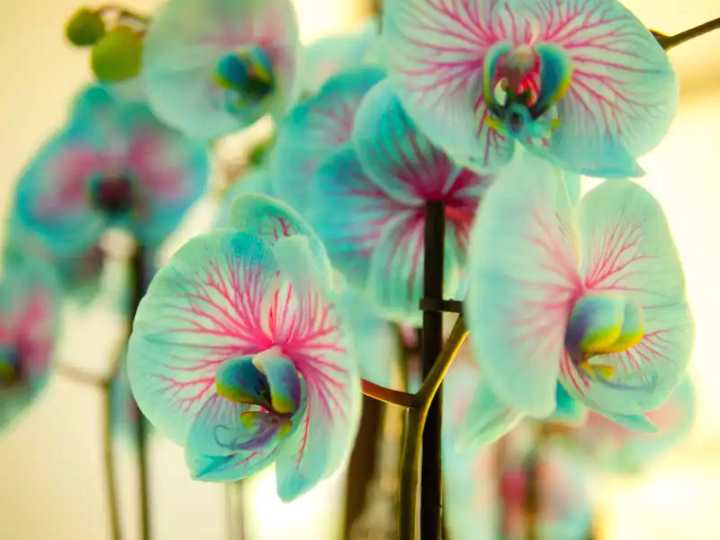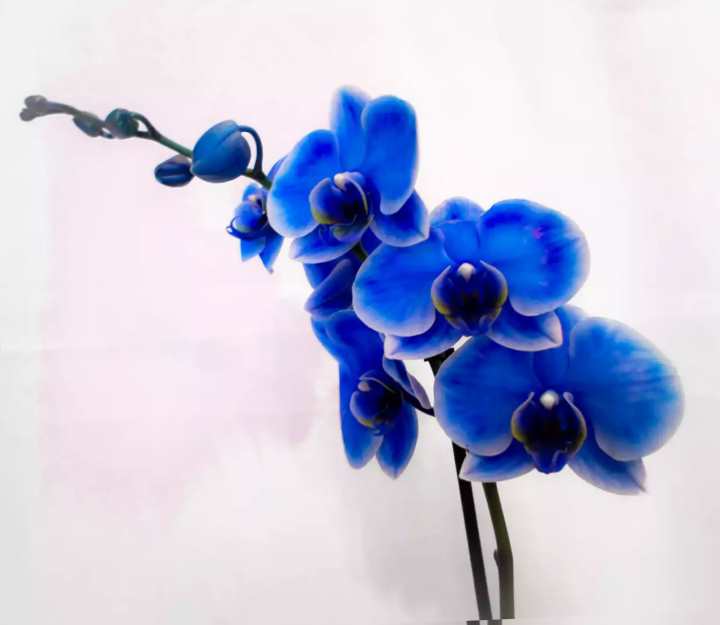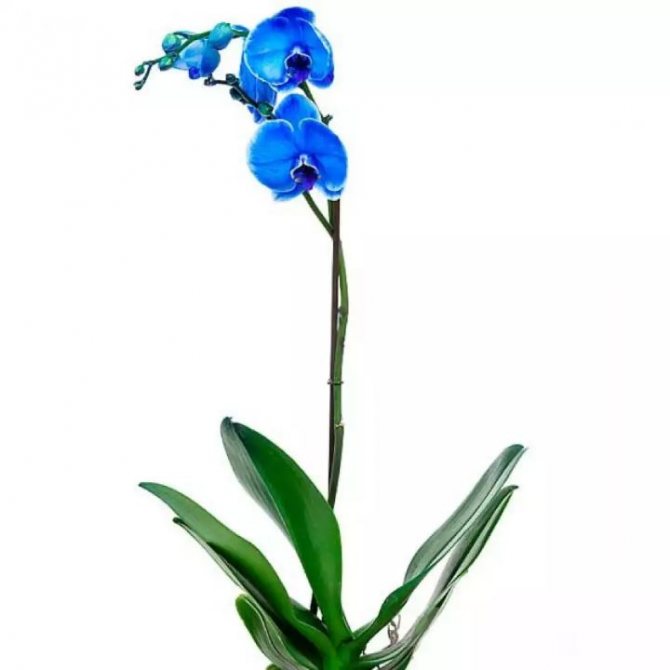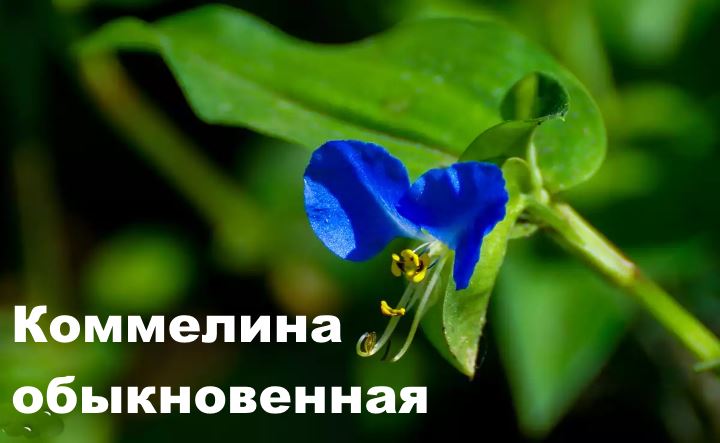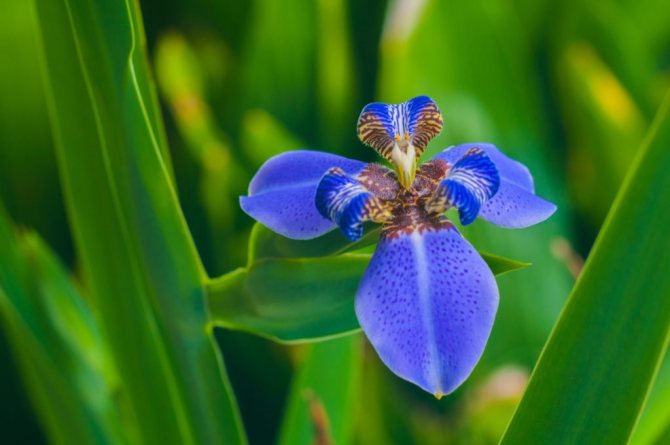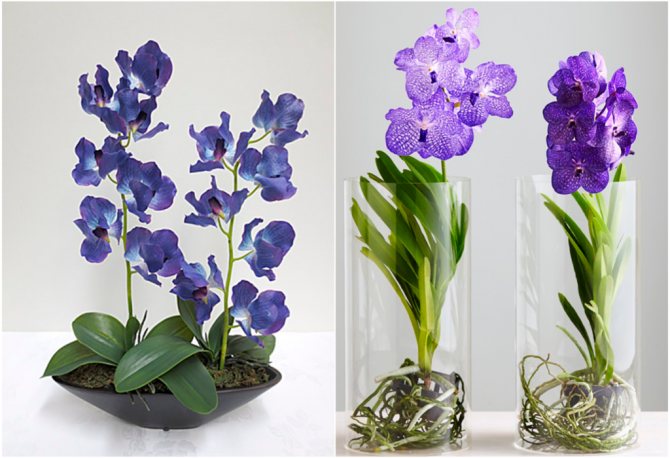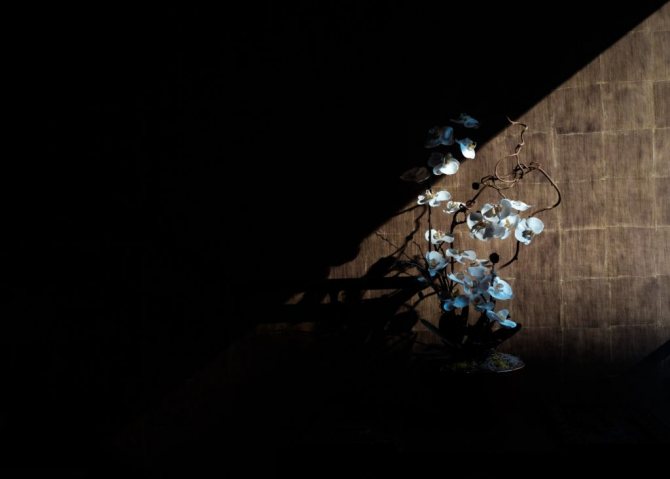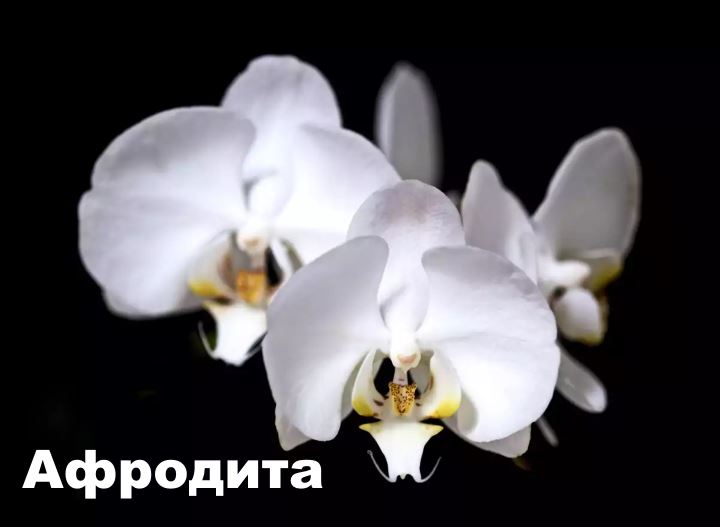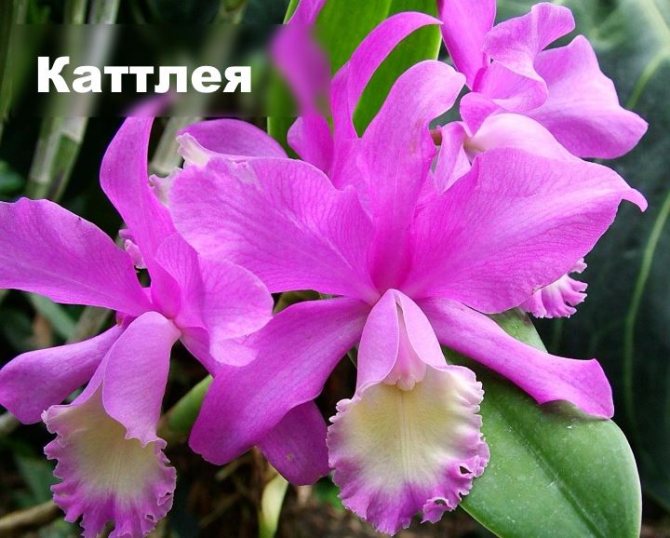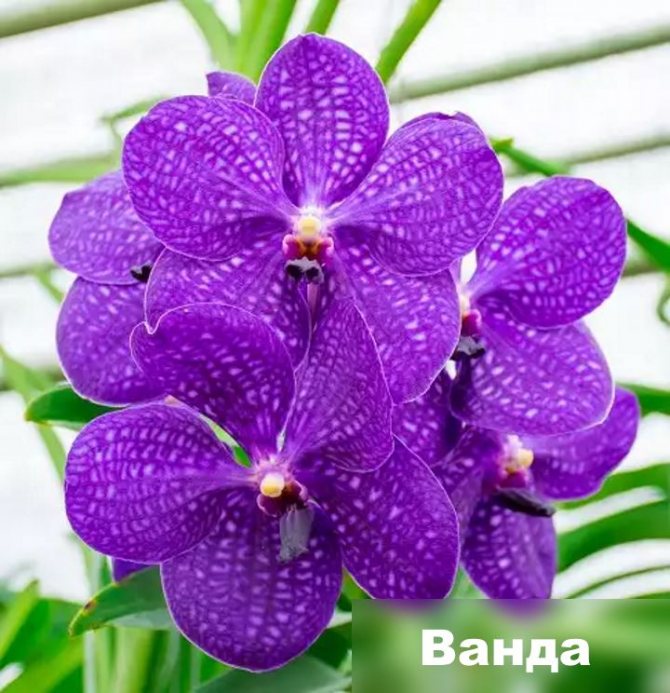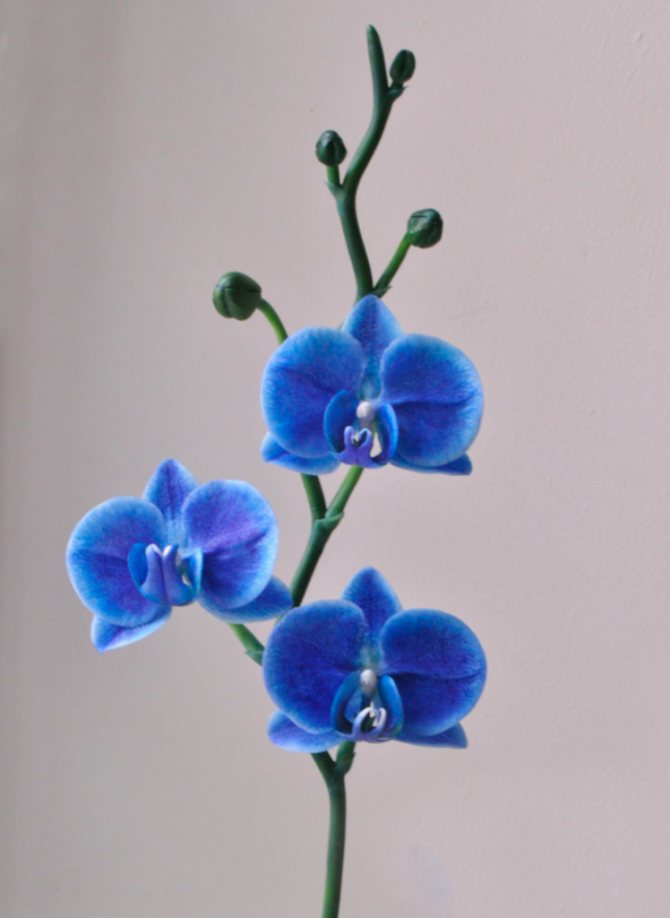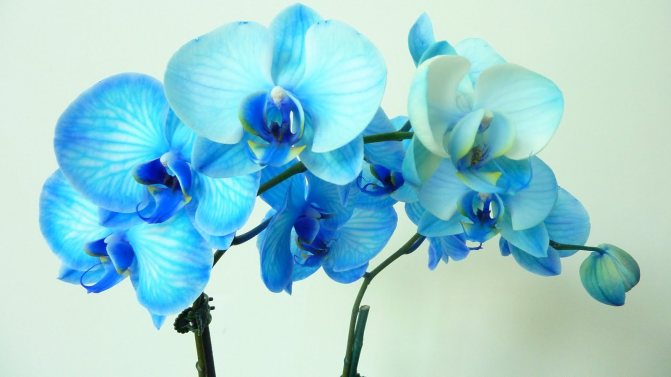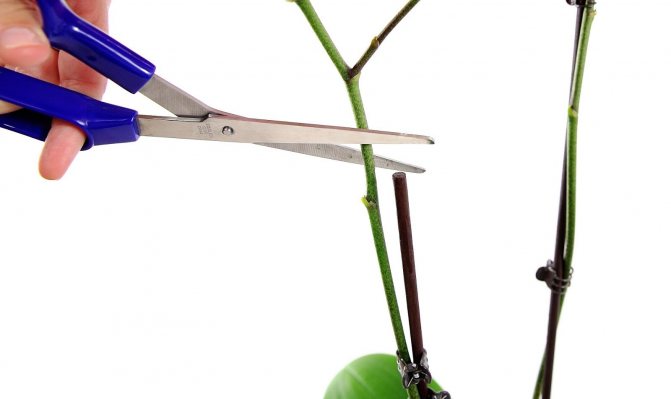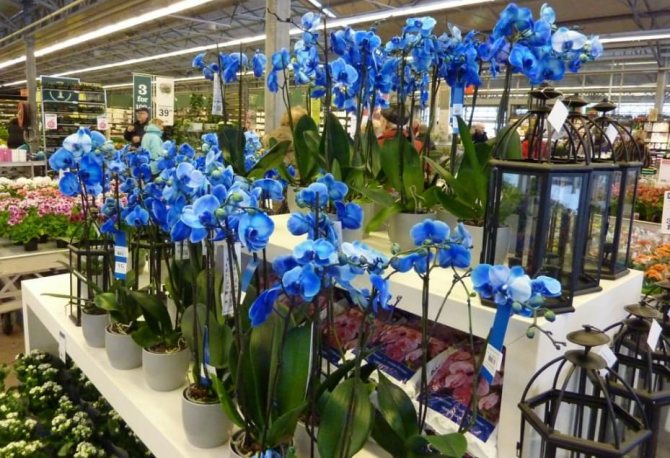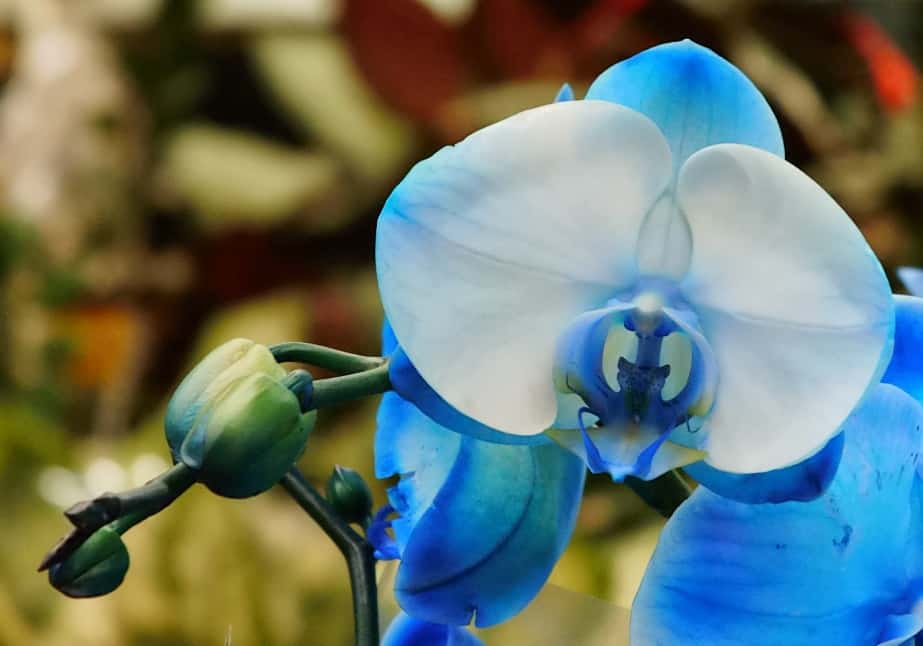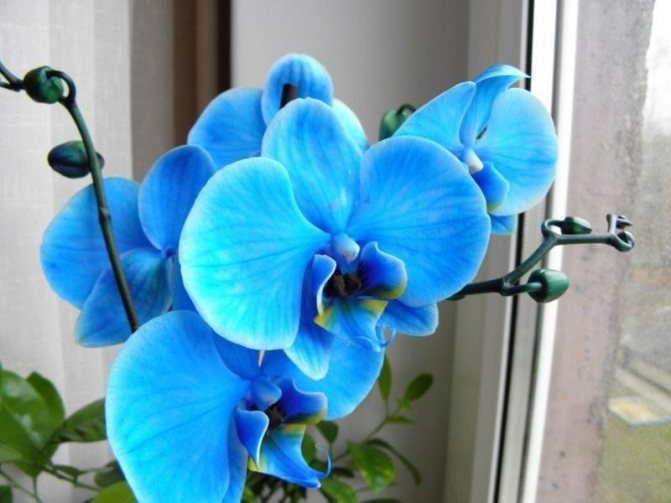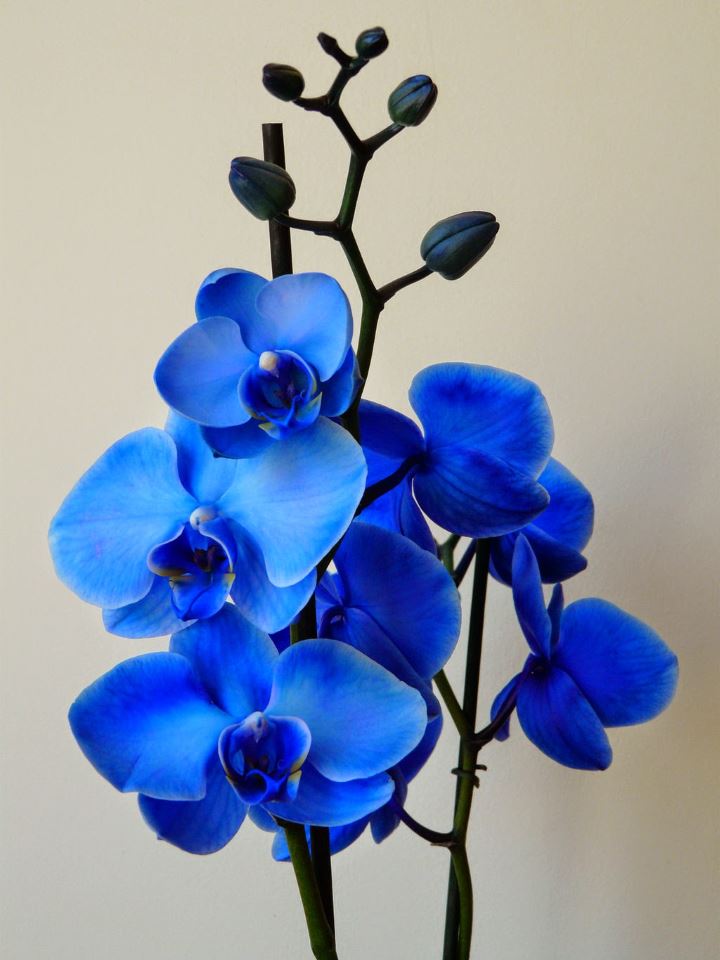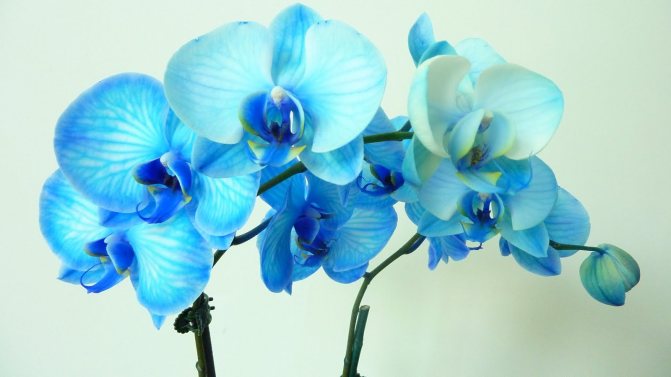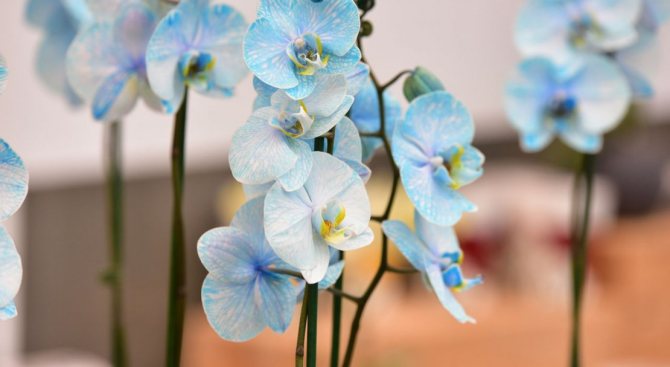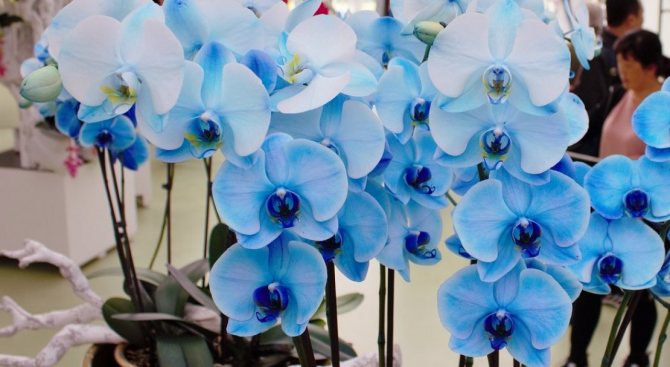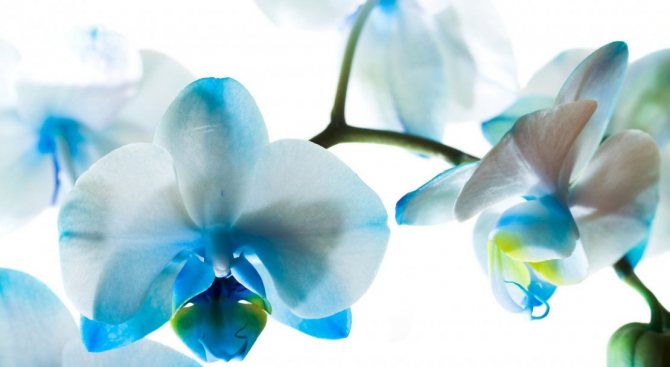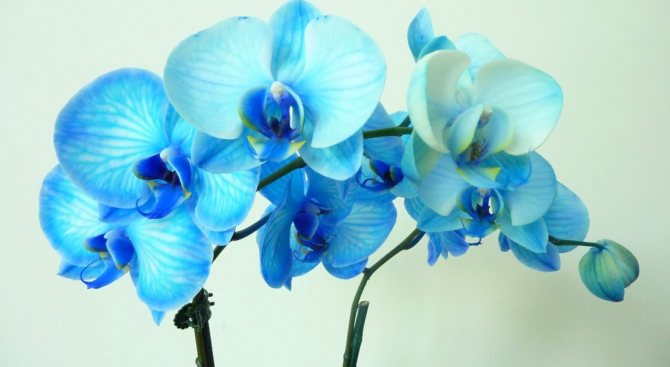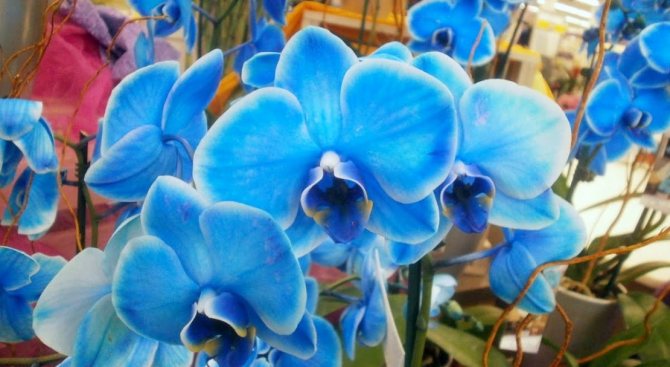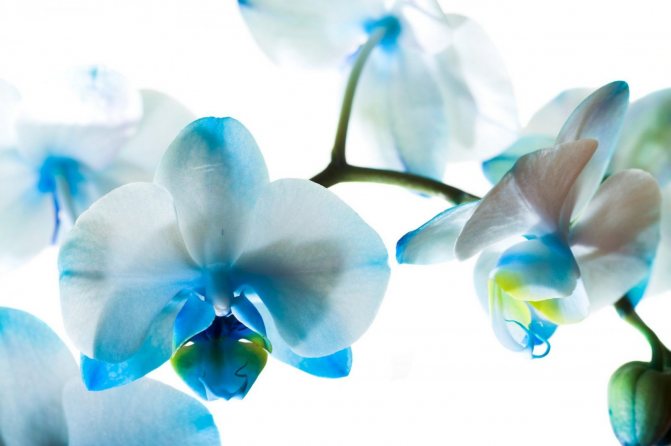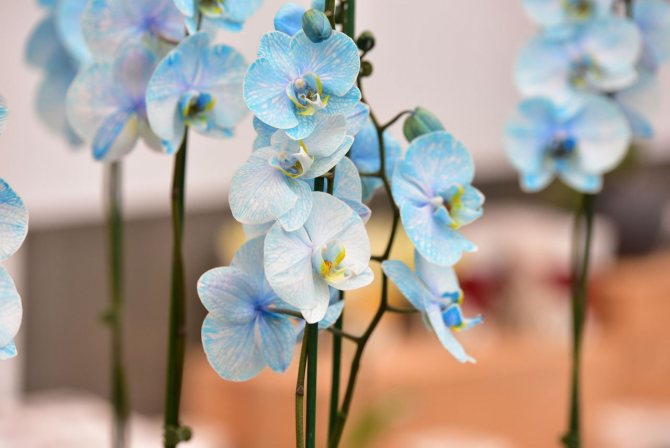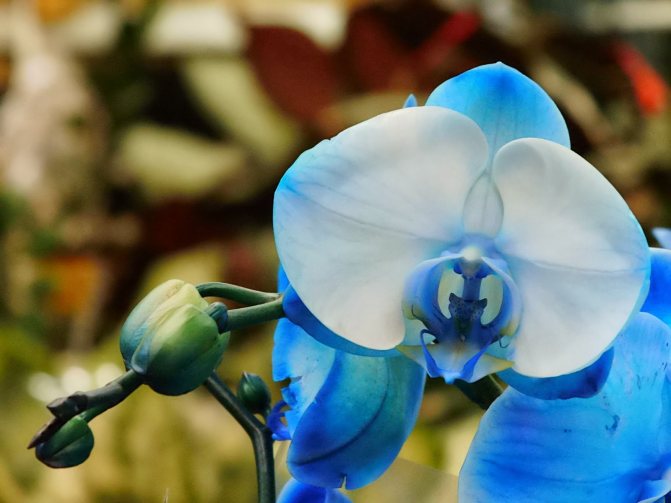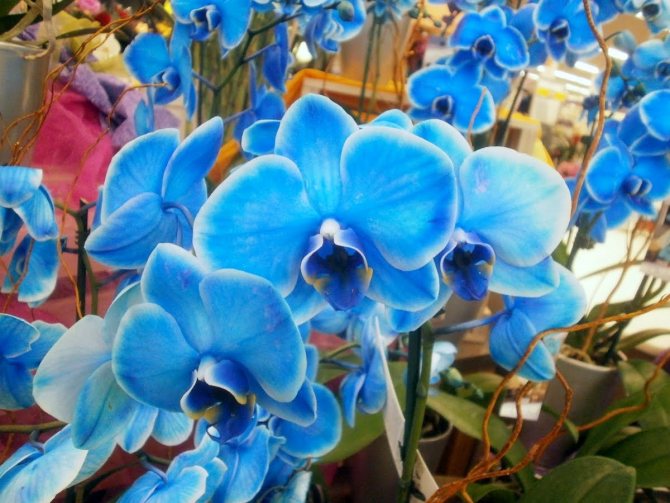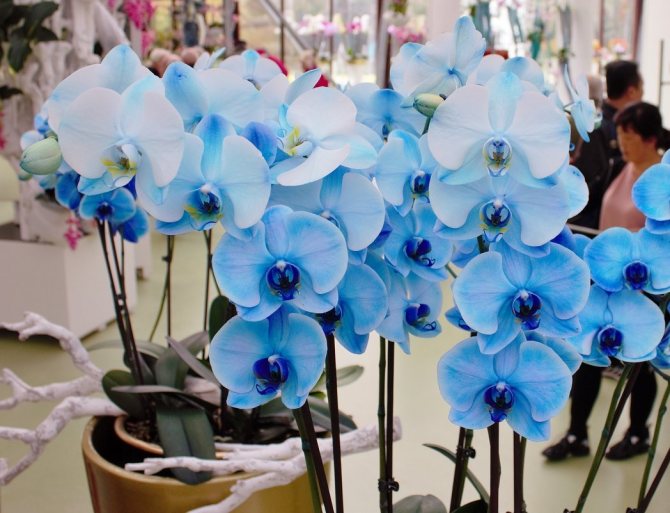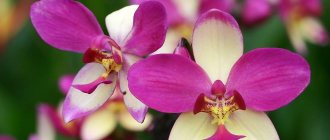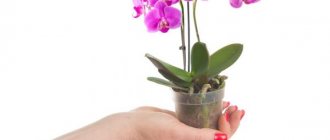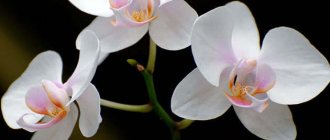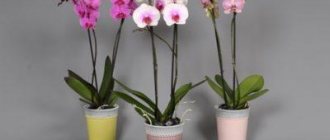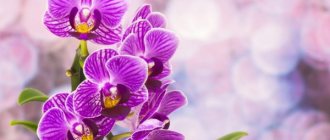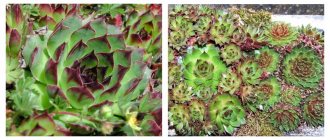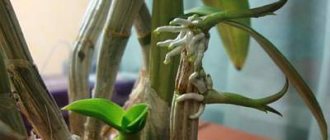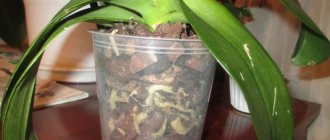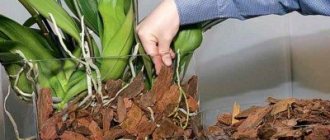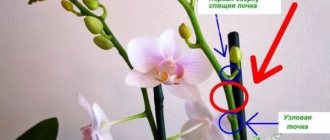Orchids
- exotic flowers with extraordinary charm. They amaze with a large number of different types, amazing shapes and colors. Recently, in garden shops, as well as building supermarkets, in departments related to gardening, you can find orchids, from the genus
Phalaenopsis
(lat.
Phalaenopsis
)
,
bright, saturated blue color. Surely, many of us attracted by such an unusual color are wondering if this is a natural color. If not real, how do orchid growers get this color?
Where does blue come from?
Of course, blue is not a natural color when it comes to orchids. However, it was noticed that there is great interest in such a curious fact. Since then, as in Florida, the first time it was introduced and a few months later the variety appeared on the market. Phalaenopsis Royal Blue
, the demand for this flower is unabated. Opinions about this orchid are divided, especially when it comes to longtime orchid growers. They talk about the lack of naturalness and interference with the color of the flower as something undesirable. Defenders of the new variety are able to agree with the fact that the color of the flower is not natural, given its uncommonness.
How do breeders get blue orchid
? By injecting a blue dye into a flower-bearing shoot during its growth phase. The dye travels to other parts of the plant, and also to the flowers. The entire operation is carried out under conditions that reduce the risk of harm to the plant to a minimum. It should be remembered, however, that such a procedure is not sustainable. The flowers that unfold after the purchase of the plant will certainly be pale or even white, since naturally white orchids lend themselves to "staining".
Less knowledgeable clients or novice orchid aficionados may be disappointed if they think that the blue color of the flower is a merit of nature and will last for a long time. To avoid misunderstandings and unpleasant situations, most sellers place on the grade Phalaenopsis Royal Blu
e
a description of how the variety emerges and what customers can expect after a long time of growing orchids at home.
Blue orchid care
Caring for a blue "variety" does not differ significantly from caring for. You just need to know just a few principles of keeping these exotic plants. Having picked up an orchid in a flower pot, we have immediately the appropriate, drained soil. It should only take care of not very frequent, but regular plants. To do this, it is better to place the flower pot in a container of water once a week. Orchids require a lot of light, but should not be exposed to direct sunlight. It also requires a lot of fresh and sufficiently humid (about 70%) air. Only in such conditions will they grow well. Remember that orchids are exotic plants that naturally grow in warm climates. We protect them from the cold wind. Fertilize orchids during the growth phase. We do this with special preparations designed for orchids, well suited to their needs.
Alternative to Royal Blue
If we are attracted, orchids with a blue tint
, however, we are not satisfied with the process of artificial creation of the above variety
Phalaenopsis Royal Blue
, in nature we have several other varieties to choose from. We may like them because of the atypical colors. One of the varieties is
Vanda coerulea
(Wanda is blue). Her flowers are almost blue. Plus, they are gorgeous, with a wonderful scent. Another species is the Australian orchid.
Thelymitra crinita
color closest to blue. Also
Aganisia cyanea
, native to South America, with characteristic blue flowers.
So, we have a choice: a real blue orchid, and blue, but artificially obtained, or "almost blue" natural color. The final decision lies with you.
(Visited 2,652 times, 1 visits today)
A customer comes to a store hoping to find a quality product. The variety of orchid flowers will surprise even an experienced grower. But some flowers simply do not occur in nature, and then it would be logical to ask the seller if he really knows how to paint an orchid and if he doesn’t use it in practice. Not bred yet unnaturally blue in nature. If you look closely at the stem of such a plant, sometimes you will notice some semblance of a bruise from an injection. With this barbaric method, the plant is given an unnatural color for it. Suffice it to imagine that the dye spreads along all the veins of a delicate flower filling every cell of the plant. This method not only does not make the plant more beautiful (but everyone has different ideas about beauty), but also ruins the health of the flower.
If, after all, such a plant has already been purchased, it is important to know how to revive the orchid and try, if not completely, then partially restore the lost health of the flower. First, you need to get the orchid out of the pot and pay attention to its roots. All rotten and dry scions must be removed. Living orchid roots will be firm and firm to the touch. Young roots are light in color when dry, and green when wet. Older roots have a light brown tint. Rotten roots will always be brown (light to dark) and hollow or slimy to the touch. When you press on such a branch, water will flow and a semblance of a thread will be free. Cut off areas must be disinfected with activated charcoal (crushed tablets) or cinnamon. If the exact cause of the rotting of the root system is not established, then it will be imperative to soak the bottom of the plant (tomesto where the roots previously grew) in a fungicide or foundation for 10-15 minutes, not forgetting to reduce their dosage by about half. Finally, the plant is treated with growth regulators. They are presented in sufficient quantities in the store where the novice gardener will help to pick them up. Now, it is known how to treat an orchid if problems arise with the plant's root system.
If the plant is rescued and it has shoots, it is important to know in advance how to plant the orchid babies. Usually, it is accepted to plant the children when the length of their roots reaches about 5 cm. Until that time, flower growers plant such a shoot with the bark, without cutting it off from the main plant. When the plant has grown and was cut off, the fresh cut is dried for 2 hours, then its roots are stirred in a saucer with a warm one for about half an hour. Further, the roots go deep into a transparent pot and are covered with bark as much as possible, but so that the growth point and the stem are not in the bark. Important! All fresh cut sites should be treated with crushed charcoal to prevent infection. Now, a novice florist knows not only how to feed an orchid but also how to choose it, avoiding barbaric handling of flowers. It is important to remember that we are all part of nature and the task of man is to protect and accept its gifts with love.
Blue orchids are striking in their beauty and rare, unusual color of petals. These flowers have appeared in flower shops relatively recently, but have already gained popularity. However, not all buyers know what the secret of the amazing color of these plants is.
What's behind the paint?
Often, happy owners of orchids with blue or blue flowers are surprised to find that in the next flowering the buds are no longer a bright, saturated color, but dirty blue, or even completely white. This is due to the fact that plants are dyed with a chemical dye
... Many stores do not hide this and place appropriate warnings on color labels. But this information is not actively disseminated among buyers, so often the owners of colored flowers are subsequently disappointed.
Most often flowers are painted white, since it is easiest to achieve uniform coloring on them. Over time, the dye is washed out and they return to their original color.
How did blue orchids come about?
In 2011, the world's first blue phalaenopsis was presented at the tropical plants exhibition in Florida (America). Made it by a growing farm "Silver Vase" from South Florida
.
Only 3 months have passed, and it became known about the appearance of another blue beauty - Phalaenopsis Royal Blue (Royal Blue Phalaenopsis). This time the action took place in Holland at the annual FloraHolland flower competition. An exotic flower with blue petals was presented by the Dutch nursery "Geest Orchideeën", for which he received an award in the "Concept of Sales" category. One of the members of the competition jury predicted the huge popularity of plants among buyers in the future.
Interesting fact: growers do not hide the fact that blue is not natural, as well as the fact that the next bloom will be white. They produce coloring by patented technology
, the details of which were not disclosed. According to the manufacturers, its essence is as follows: the plants are placed in a special environment, for the creation of which elements of natural origin are used, so the procedure itself does not harm the orchids.
We can conclude that blue is not a natural species and not a hybrid bred by breeders. This is just a marketing move, and, I must say, a very successful one.
Flower in the house: care features
The problem lies in the fact that some unscrupulous sellers, wanting to earn extra money, take on coloring on their own. They pass off the result of their work as Phalaenopsis Royal Blue and sell for three times more than ordinary white flowers.
Naturally, we are not talking about any technology here. Sometimes coloring is done simply barbaric methods
... The dye, often ink, is injected into the peduncle, stem, or root. This procedure greatly weakens the plant, being a source of stress for it. Poisoned by harmful substances, the flower may simply die.
Having bought or received a blue plant as a gift, carefully examine it. If the injection mark is visible on the peduncle, then the plant has a better chance of survival. If the injection was done into the root, then there is a high probability of death.
Sometimes phalaenopsis is painted by watering with colored water, in this case, you can observe a blue tint not only on flowers, but also on leaves and roots. Whether a plant survives or not depends on the degree of harm done to it.
The orchid has released buds not blue, but white? No need to try to paint it yourself, water it with blue or ink. From this plant can get sick and die
... Better to enjoy her natural, no less beautiful outfit.
Do not rush to transplant a dyed plant immediately after purchase - it may not withstand another stress. Otherwise, the care requirements are the same as for ordinary orchids, but you need to carefully monitor its condition.
If, after the purchase, the flower began to lose buds, it means that it did not cope with the negative influence of the coloring matter. In this case, you need take urgent action to save him
... To do this, you should:
How to tell if it's dyed or real?
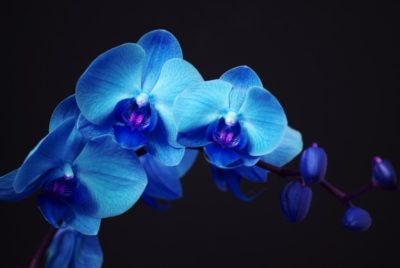
In order to determine which orchid is in front of you - artificially dyed blue, or not - you need to pay attention to such details as:
- Stem appearance... It should be of a natural color, without various impurities.
- Flower condition... If you lightly run your finger over an artificially colored flower, then a trace of paint will remain on the skin.
- Substrate... The soil in which the orchid grows should be of a natural color. This indicates that no attempt was made to tint the flower.
When buying a dyed flower, it is important to understand that it will require more care, as it has undergone serious intervention.
Japanese miracle
In 2013, Japanese breeders presented the result of their many years of work - a transgenic blue orchid. As a basis, scientists took the white phalaenopsis Aphrodite, which itself is very fertile and can release up to 30 flowers in one flowering. The plant was injected with the gene responsible for the blue color from the Commeline flower.
One of the visitors to our forum (Anna) asked us for advice: "". Surely many of you have already seen such a "miracle" in stores. Other posts in the thread show that every second buyer of a "miracle" subsequently feels cheated.
And since there are many myths, rumors and legends around the blue orchid, we decided to help you understand this issue. And you yourself will decide whether to buy or not to buy.
Staining methods
Patented color
The Dutch nursery method is patented. They explain:
- A certain environment (temperature, dyes) with natural elements is created;
- White phalaenopsis are used. They are posted on this Wednesday. The creators claim it is safe for orchids;
- Flowers are colored not only blue;
- The price for them is solid. 2-3 times higher than others.
How it was bred by the Americans is unknown to us. Japanese copies have not yet been offered. Or maybe we don't know yet. And our dealers implement them.
White phalaenopsis are used for staining.
Peduncle injections
- Not everyone can purchase patented blue orchids. ;
- And if they ask just such, then it can be created on the spot. And on the Internet they will tell you what and how to paint;
- One of these methods is peduncle injection. In its lower part. It is not so dangerous for the whole plant. If it fades, other stalks will have lighter flowers.
By the way! Many are calm about this. I remember one phrase: “We do it all the time in our garden shop. So I have a good experience. People are grateful for the advice and tips. "
Root injection
The results of injections into the root of the plant can also be seen. This is definitely a one-time gift. Only who will like this cyanosis? And it is already more difficult to save such a plant.
Why is self-coloring dangerous?
The introduction of various dyes greatly weakens the plants. After all, there are advisers to add dyes when watering. And they recommend special paints for flowers or food colors. And they can help you get them.
I don't really understand such florists. For what? Money - I will believe. But not love for flowers.
Ordinary ink is also used as dyes. And there are also solvents.
There may be wilting and dropping buds.
Attention! Ultimately, the plants may die. And even the efforts taken to rescue may not give a positive result.
And the phalaenopsis is white!
Just like in the fairy tale about the naked king.
These flowers really look magical, you just can't take your eyes off!
But from everyone who bought phalaenopsis with blue flowers, the following bloom after the store bloom brought flowers either white with bluish stains (where the paint has not yet come off), or pure white. For those unfamiliar with orchids, this was a big disappointment, as they initially thought it was a natural blue.
Yes, unfortunately, all blue phalaenopsis sold in stores and even at most exhibitions are some kind of standard varieties with white but dyed flowers ...
Advice
When choosing an orchid in a store, it is better to bypass specimens with bright blue, saturated petals. These flowers are inflated with so much paint that no small amount of harm can be done to them. Often, after purchase, soon such an intensely colored orchid dies.
If you are determined to purchase a tempting blue specimen, ask the seller how the plant was colored before buying.
Examine the flower - if there are injection wounds on the trunk, you should not purchase such a plant. The introduction of paint through the trunk is experienced by the plant more difficult than other methods.
At home, it is better not to risk painting the orchid. Not all plants will be able to survive the procedure safely. Better to opt for one of the varieties with natural light blue or purple petals.
So, a blue orchid, like a blue bird, actually turns out to be a real invention, an unrealistic dream, a deception. As we said above, there is no blue pigment in the genes of this botanical species, so color can only be obtained by staining. However, this fact should not upset flower lovers: there are other varieties, the color of the petals of which is close to blue, lilac and purple shades.
Short video
Some stores do not even hide this and write on the plate under the price tag that this is not a natural color and the orchid blooms with blue flowers only once. This is at least fair to the buyers.
However, not everyone is so honest. There are many sellers who pass off dyed phalaenopsis as a supposedly very rare natural species and fight for it at exorbitant prices. And they call it - Phalaenopsis Royal Blue, which can be translated as Royal blue phalaenopsis.
But in the DNA of natural phalaenopsis there is simply no gene that gives the blue pigment. Therefore, if you are convinced that this is a species orchid, this is pure deception.
Although Phalaenopsis Royal Blue does exist, it is not a natural species, or even a hybrid. You will not find such a name in the list of officially registered hybrids. And what is it - you will find out below ...
Who created the world's first blue phalaenopsis?
We found mention of only two manufacturers of such phalaenopsis. Perhaps there are many more of them, but these two are, one might say, pioneers.
The first is Silver Vase, an orchid and bromeliad farm founded in 1988 in South Florida. In January 2011, at an industrial exhibition of tropical plants in the resort town of Fort Lauderdale (in Florida, America), they presented the Phalaenopsis Blue Mystique - the world's first blue phalaenopsis.
The first in the world - at least that's how it is written on their website https://enn.imadeself.com/about-us/. Here he is, handsome:
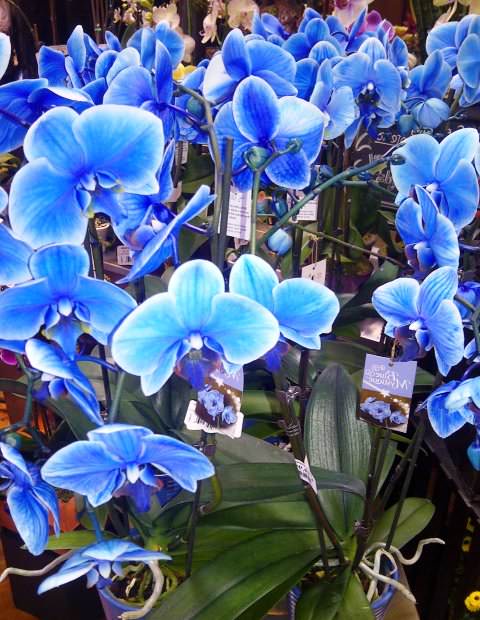

The second producer is the Dutch orchid nursery (family company) Geest Orchideeën (VG Orchids), located in the provincial town of De Lier in the south of Holland.
The Holland hosts the annual FloraHolland flower auction / competition, which awards the Glass Tulip award for the best marketing introduction of the year to the flower market. Plants are judged in several categories: Cut Flowers, Indoor Plants, Garden Plants, and Sales Concept. In each of them, 3 winners are selected.
So, in May 2011 (3 months after the Silver Vase in Florida with its Phalaenopsis Blue Mystique) the Dutch cattery Geest Orchideeën presented its Phalaenopsis Royal Blue to the FloraHolland competition. And it won first place in the Sales Concept category. One of the judges named it the best marketing concept for sales and said, "Consumers will have this delicious blue orchid in great demand." What actually happens is how the jury looked into the water. For some, the desire to buy a blue orchid reaches insanity. Straight mystical orchid ...
But on the photo is the owner of the cattery "Geest Orchideeën" and his prize-winner Phalaenopsis Royal Blue, and he is just one representative of the whole Royal family (more about this family below).


And moreover, not a single manufacturer hides that the next orchid bloom will be white. When sold, this is indicated on the label, and there is also information about this on their websites.
But who is still the first of them is not entirely clear. Silver Vase seemed to be the first to show the world their Blue Mystique.However, the site "Geest Orchideeën" https://www.vgorchids.eu/ru/vg-colours says that they put on the market dyed phalaenopsis back in 2009, and they also patented the dyeing technology itself, to which they came as a result long years of experience and experimentation. Today, orchids colored according to their technology are sold all over the world: in Europe, the USA, Brazil and Japan.
The process of this technology, of course, is not released to the general public. As well as the type of dye. It is not recommended to paint orchids on your own, because there is a risk of harming them.
The manufacturers themselves do not even call this process dyeing. Here's how it is described: using the technology, phalaenopsis with white flowers are placed in a specially designed environment in which elements of natural origin are used, which makes this process safe for the plant itself.
By the way, “Geest Orchideeën” has more than one colored orchid, they have a whole collection, or as they call it - the Royal family. Here she is:
As you can see, besides Royal Blue (top row in the middle), there are other shades here. Perhaps they really have been creating this collection since 2009, and blue turned out to be simply the most successful shade, for which he received an award. Silver Vase also has a collection, but small - of 3 color variations.
So Phalaenopsis Royal Blue, like Blue Mystique, is neither a natural species nor a hybrid. "This is marketing, baby!"
And in Europe, colored orchids are treated in a completely different way than here. For them, it's just like a one-time beautiful bouquet. When they buy, they know that the blue color will disappear later. And very many, after this happens, either throw away the plant, or resell their already white phalaenopsis on Ebay.
Home dyeing
You can make blue phalaenopsis yourself, while you will save a decent amount of money and choose exactly the shade of blue that you like. This procedure is simple, and a beginner can carry it out without problems. The main thing is to adhere to this scheme:
- First, select a plant. It is best to take phalaenopsis with white flowers, healthy, without diseases and pests;
- The next step is to select the coloring element. It is better to give preference to special means for coloring flowers or, at worst, food coloring. The final result depends on what the blue orchids are painted with;
- The process ends with the choice of the staining method and its direct implementation.
After all this, the trunk will need to be paid a little more attention, since any dye will negatively affect the condition of the plant.
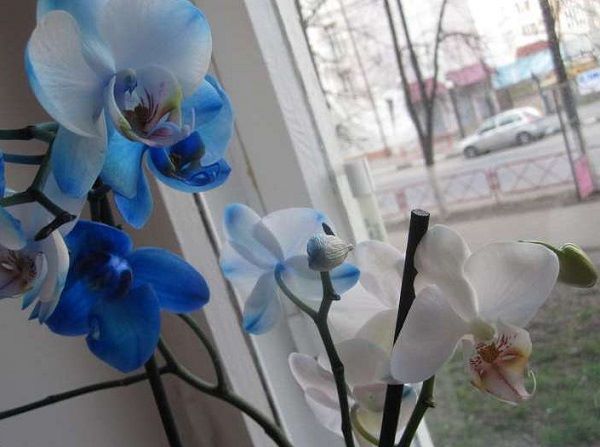

Phalaenopsis in the process of staining.
Staining is best done when the peduncle is fully grown and the flowers begin to bloom little by little. It is this period that will be the most favorable, the coloring pigment will quickly get into the flowers and will minimize the damage to the stem.
Advice! Do not carry out the staining procedure at every flowering, this can take the last strength from the plant and it will die.
The ways
There are two ways to change the color of a phalaenopsis:
- The easiest way is to regularly water the stem with a colored liquid. You will notice changes in color pretty soon, but the dye will also be in a hurry to leave the stem. Loss of color will begin immediately after watering is stopped;
- The second method is less humane: in order to get a phalaenopsis with blue flowers, you need to give it “injections” of color. Typically, such injections are carried out into the roots, stem or peduncle of the stem. After that, traces usually remain on the plant, which will be noticeable for a long time.
Advice! If you decide to use the second method of staining, make "injections" in the peduncle. This will do the least damage to the orchid.
Not everything Phalaenopsis Royal Blue is blue!
Everyone has heard about the popularity of blue orchids. And, as you know, demand creates supply. Some artisan sellers do not buy orchids for sale that are painted using this exclusive technology, but go in a cheaper and easier way - they themselves undertake coloring. And this most often leads to disastrous results - the plant dies.
If you look at the works of such craftsmen, you can understand that this is done simply barbarously. Any dye of blue color is taken, often it is ordinary ink, and is injected with a syringe into the stem, or roots, or into the peduncle.
Those who receive a shot in the peduncle usually survive, but then they can get sick for a while. But those who were pricked into the stem or roots often simply suffocate from the paint and die.
So, if you notice that Phalaenopsis has blue not only flowers, but also roots and leaves, we do not recommend buying it, because most likely he will die.
Negative consequences
Artificial coloring is a serious interference with the organic structure of a plant.... In case of a mistake made during the procedure, you can lose the flower. If everything is done correctly, you need to remember that the dye will greatly weaken the plant, it can hurt for a long time. In order for the orchid not to die, it is necessary to constantly monitor its well-being. It is recommended to protect the diseased plant from direct sunlight, water it using organic fertilizing.
In no case should the flower be transplanted immediately after the artificial staining procedure. A weakened plant will not survive surgery and will most likely die.
Transgenic blue phalaenopsis from Japan
In February 2013, the 11th Orchid Conference of the Asia-Pacific Region was held in Japan on the island of Okinawa. Masahiro Mii from Chiba University attracted a lot of attention at this conference with his talk “Genetic Transformation of Orchids and Production of Transgenic Blue Phalaenopsis”.
Of course, he also presented the real result of many years of experiments by a group of genetic engineers and breeders at Chiba University.
This is Phalaenopsis Aphrodite with white flowers, which has been implanted with the "blue" gene of the Commeline flower (popularly blue-eyed), which grows in Asia. Phalaenopsis Aphrodite is quite fertile - it can release up to 30 small flowers with a diameter of 5 cm per flowering. Blue orchids were presented in nominal and peloric forms.
However, it is not soon that such a product of genetic engineering will become available to ordinary flower growers.
Diseases and pests of blue orchids
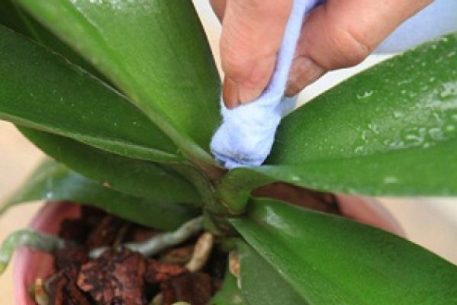

During flowering, the blue orchid is most vulnerable, and can be attacked by harmful insects and pathogens:
1. Ticks. A cobweb appears on the plant, the leaves begin to turn yellow, dry, fall off. You can get rid of an insect using ordinary soapy water or diluted ethyl alcohol. Spraying products such as Fitoverm can be purchased in garden stores. 2. Worm. The creature is small, resembles a white worm. Means "Biotrin", "Mospilan" help to get rid of it. 3. Rot. Small brown spots appear on the stems and in the area of the roots, similar to growths. Over time, it is in these places that the plant begins to dry. The reason is improperly organized watering and high humidity in the room. Correct actions: rinse the root system of the flower, get rid of the affected areas, replace the substrate and ensure the correct indoor climate. The blue orchid is a beautiful flower. But they achieve such a shade in a real barbaric way, introducing a coloring pigment into the root system of the plant. This causes stress to the orchid and in most cases it starts to get sick and dies.
Is there really no blue phalaenopsis in nature?
There is no such bright blue color as painted ones. There are pale blue, blue with a lilac tint, pink-blue, white with a gray-blue tint. Such shades are very rare for phalaenopsis. These are mainly species plants with small flowers and primary hybrids based on them.
For example, natural blue forms:
- Phalaenopsis violacea coerulea
- Doritis pulcherrima coerulea
- Phalaenopsis equestris cyanochilus
And some famous hybrids:
- Doritaenopsis Peter "Blue Sky"
- Doritaenopsis Purple Martin "KS"
- Doritaenopsis Kenneth Schubert "Blue Angel"
- Doritaenopsis Siam Treasure "Blue"
Although these orchids have small flowers, but the shades are the most natural, without staining.
Now you know everything about blue phalaenopsis. And which one will become your pet, decide for yourself.
Orchids are considered one of the most beautiful flowers on Earth and are popular with flower growers in all countries. This is not surprising: the bizarre shape of the petals, size and relatively rapid growth distinguish them from thousands of other plants. But the most unusual among them is, of course, the blue, or blue orchid.
Several sources claim that blue orchids do not exist in nature
... Such a myth arose due to the huge mass of fakes. Unscrupulous sellers simply paint the corollas of flowers with the help of special pigments, and then pass them off as a blue curiosity. So the flower will turn blue and become a "blue" orchid.
Painted phalaenopsis is identified by pigment residues on other parts of the flower.
Royal phalaenopsis are subjected to similar manipulations - plants from the Orchid family, native to Southeast Asia, with flowers of white, purple or pale pink.
To recognize the "dyed phalaenopsis", pay attention to other parts of the plant
: there are traces of blue pigment on them, and do not buy a fake.
Only in 2011, real blue phalaenopsis appeared - Phalaenopsis Royal Blue, which are grown in Florida and Holland. The Dutch company Geest Orchideeën has grown several varieties of phalaenopsis in different shades of blue
, with purple and even green hues.
Types of blue orchids
Rare orchids - blue and blue, are very popular in the floriculture market. Before answering the question "are there blue orchids in nature?", One should understand the theoretical basis of the biology of orchids. Almost all orchids are devoid of dolphinidin, an anthocyanin that colors flowers blue and blue. Therefore, there are no blue or blue phalaenopsis in nature, and only orchids of the genus Wanda and Cattleya can boast of blue and approximate shades of flowers.
Blue phalaenopsis
During the entire existence of the blue phalaenopsis, many rumors and legends have formed around him. Today, all specimens of blue and blue phalaenopsis can be divided into three groups:
- artificially colored;
- hybrid bred;
- species phalaenopsis of blue and similar shades.
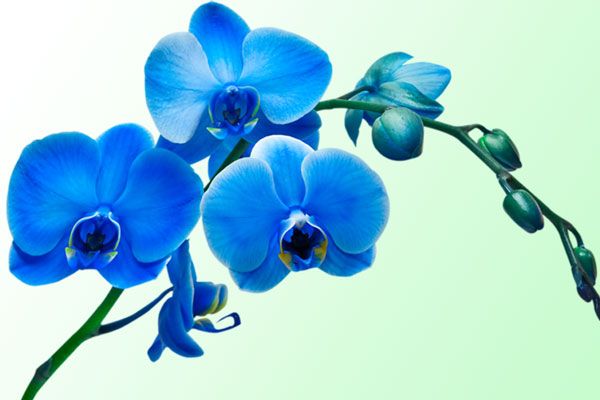

Colored
The phalaenopsis DNA lacks the gene responsible for the presence of the anthocyanin delphinidin, so most blue and blue phalaenopsis are artificially colored specimens. Such plants bloom blue only once. In subsequent flowering, the orchid will have flowers of white or blue shades.
Plants like this are a common commodity in the flower markets of the world. In rare cases, the seller warns about artificial coloring of the orchid, more often - the news of the coloring becomes a surprise for its owner and often unpleasant.
Often, to dye phalaenopsis blue and blue, sellers resort to barbaric methods: the dye, often unsafe, is manually injected into the area of the peduncle, stem or root, which leads to plant poisoning. If the injection was made in the peduncle, the orchid has a chance of recovery, but basically, such damage to any part of the plant leads to its inevitable death. In this way, phalaenopsis are dyed not only with the help of a special dye for flowers, but also with ordinary food, in the most advanced cases - with ink.
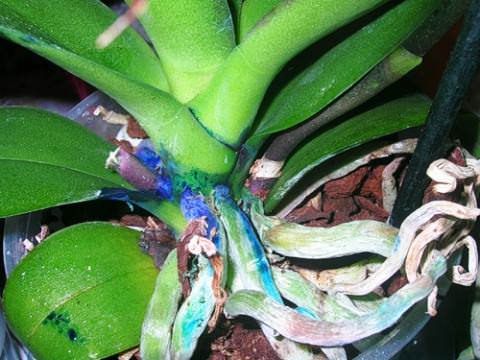

Sometimes phalaenopsis are dyed by sprinkling with blue colored water. In this case, the root system of the plant suffers the greatest damage, and the soil after the procedure cannot be restored. The leaves and stems of such an orchid become blue or blue, often the plant withers and loses flowers.
It was the harm caused to orchids by careless market coloration that prompted plant breeders to patent a safe technology for giving orchids blue and light blue colors. Two flower nurseries are considered pioneers in the safe coloration of phalaenopsis orchids in blue and cyan. The first, Silver Vase, presented Phalaenopsis Blue Mystique in 2011 as an exhibitor at the Industrial Exposition of Exotic Plants. The farm was organized back in 1988 in Florida, USA.
The second blue phalaenopsis nursery is called Geest Orchideeën and is located in the southern part of Holland. The company presented its blue orchid called Phalaenopsis Royal Blue at the FloraHolland competition three months after the presentation of the Phalaenopsis Blue Mystique.
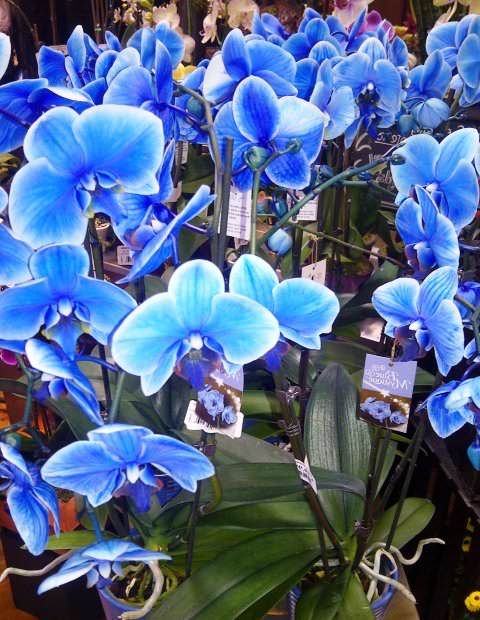

Both manufacturers do not hide the fact of artificial coloring of their orchids. The process of giving phalaenopsis a sky-blue color is carried out using a patented technology, which involves placing the orchid in a special environment and dyeing its flowers in a safe way.
Naturally, flower markets are full of blue orchids that have nothing to do with the two above mentioned producers. To distinguish the original Phalaenopsis BlueMystique and Phalaenopsis Royal Blue from a fake, it is enough to inspect the orchid - the plants should be free of damage, and their leaves and roots should not be blue or blue.
With careful care, the artificially colored orchid does quite well. Over time, the dye can be washed out and the next flowering of such an individual will be accompanied by white flowers. Such a flower does not need special care, provided it is in good health. It must be kept in the same way as ordinary phalaenopsis.
If the condition of the flower does not improve, and the flowers begin to fall off, it is necessary:
- Remove the plant from the pot, examine the roots, and, if possible, wash them with warm water.
- Cut off ink or dye injection sites, as well as rotten, non-viable roots.
- Prune stalks containing harmful dyes.
- Sprinkle "wounds" with crushed activated carbon, ash or cinnamon, dry well.
- Remove the old soil from the pot, replace it with a new one. It is better to purchase the substrate in a specialized store, at home you can also use pine bark, sphagnum moss and peat.
- Plant the plant in a new pot, providing long-term illumination with diffused light, as well as a temperature not higher than 30 degrees during the day.
- Provide the plant with fresh air and high humidity (above 30%).
- Feed the flower no more than once a month, water it if necessary.
Hybrid
Despite the difficulties in growing blue phalaenopsis, in 2013, a transgenic blue orchid was presented at one of the orchid exhibitions held on the island of Okinawa. The result of a complex selection was presented by Chiba University under the name Phalaenopsis Aphrodite. Phalaenopsis aphrodite - originally a white orchid, which was introduced to the gene of the Asian commeline, which is responsible for the production of blue pigment. Hybrid blue phalaenopsis is extremely fertile - it can produce up to 30 flowers in one flowering. Due to its uniqueness, the flower is not available to the common man to this day.
Species blue phalaenopsis
Among the species phalaenopsis, specimens painted in bright blue or blue colors are not found. A few species of plants, as well as hybrid individuals based on them, can boast only blue shades of flowers with various tints. Such plants have small flowers in small numbers, but, unlike colored phalaenopsis, these plants boast natural, natural shades. Such instances include Phalaenopsis violacea coerulea, as well as Doritis pulcherrima coerulea... Both orchids are monopodial, epiphytic and native to Sumatra and Malaysia. Based on their genome, hybrid species Doritaenopsis Peter "Blue Sky", Doritaenopsis Purple Martin "KS" and others were created.
Cattleya Dinard
In nature, Cattleya grows in the territories of South and Central America, and the number of their species reaches about 65. Cattleya grows well in a flowerpot and has quite spectacular, pleasantly smelling flowers.Its stems are cylindrical, thickened and have several leaves. Cattleya species are considered to be thermophilic plants, with the maintenance of which it is especially important to maintain warmth during the winter period of growth. In cold seasons, Cattleya require additional lighting, so flowers should be placed on well-lit windowsills. As for the summer period, at this time the plants should be shaded, as a period of active growth begins.
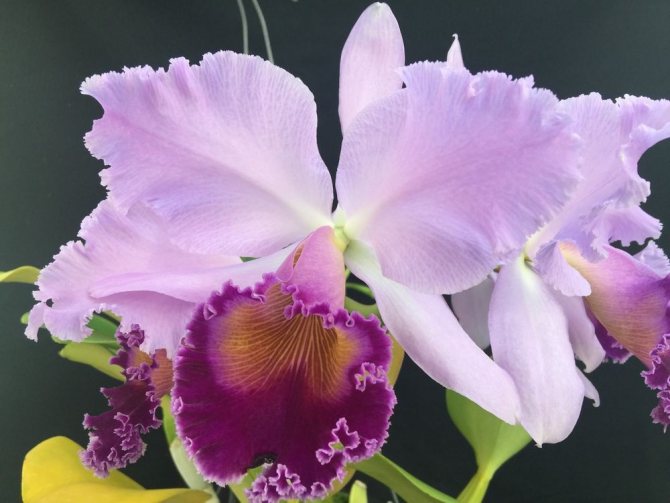

During this period, active, abundant watering of the plant should be introduced, as well as regular ventilation of the room. In the winter season, Cattleya does not require abundant watering, on the contrary, the water supply should be significantly reduced by increasing the level of air humidity.
Fertilizing Cattleya should be done twice a month, in summer and spring. The best top dressing will be mineral fertilizer. The flower should be transplanted no more than once every 3-4 years, and only after the flowering period. The substrate may contain shredded bark, peat, and sphagnum moss.
During transplantation, the rhizomes should be divided - the Cattleya reproduces in this way. It is necessary to ensure that each part has at least one growth point and two pseudobulbs. The cut points are sprinkled with activated carbon, or ordinary wood. Some are transplanted into moistened soil, reducing watering for a while. For better development of the root system, hormonal agents are also used to stimulate plant growth.
Cattleya Dinard, which is a hybrid of the Cattleya genus, has a sympodial shoot and large, pleasantly smelling flowers of sky blue or lilac shades. The most popular is a clone of Cattleya Dinard "Blue Heaven", awarded the American Orchid Society honors diploma.
Orchid Wanda
Vanda is a thermophilic epiphyte, a distinctive feature of which are especially powerful aerial roots and rather large, attractive, pleasantly smelling flowers on long peduncles. The plant blooms for a long time - up to three months, and periodically - several times a year.
The most famous species of this plant is Wanda blue... These flowers are native to China, Thailand and India. The flower is distinguished by an impressive inflorescence - up to 60 cm in length with large pale blue flowers up to 8-10 cm in diameter, with bright blue veins. Blue Wanda is the progenitor of many hybrid orchid species. The flower has one feature - for a normal existence, it requires coolness. This behavior is not common in the orchid world.
No less spectacular flower of the genus Wanda is a hybrid called Rothschild, grown by crossing Sandera and Wanda blue. From Wanda blue, he received an unusual color of blue and blue tones, large flowers on a long peduncle, from Sandera - large flowers with tightly gathered petals and a mesh pattern. Rothschild is cold-resistant and has a four-week flowering period.
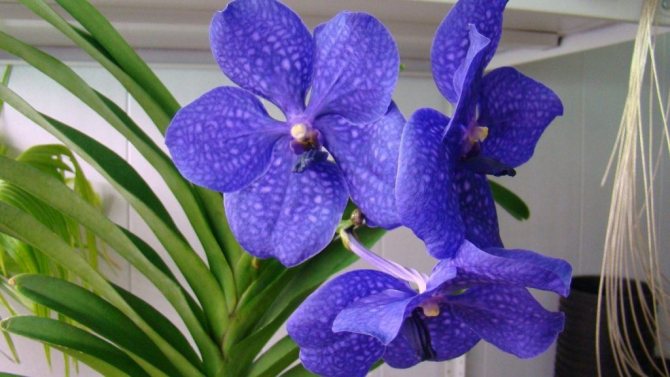

Almost all types of vanda can be placed on windowsills, as these plants require more light than other types. Some species require additional lighting not only in winter, but also in summer. Orchids usually love warmth, with the only exception being Vanda blue.
The vanda orchid loves warm watering with a little lime. During the period of active growth, additional plant fertilization is required. The feeding procedure should be carried out every two weeks, using ready-made fertilizers for orchids.
Wanda does not tolerate frequent replanting, as its root system is quite fragile and can be damaged. For transplantation, a special substrate for epiphytes is used, it is better to do this in the spring, after the complete decomposition of the previous substrate. Wanda reproduces by dividing the bush and children.
Appearance, flowering and reproduction
Phalaenopsis are epiphytic plants that live on tree branches and feed on aerial roots.Leaves are elongated, belt-shaped or lanceolate, bright green, shiny and fleshy. The leaves are arranged in two rows, like many other orchids. Phalaenopsis have short stems, but peduncle can reach a meter
and even one and a half meters.
These plants do not have any clear flowering schedule, since they live in tropical forests.
Most often flowering occurs in late spring.
because there is more sunshine in this one.
Orchids reproduce vegetatively. For this, side shoots are used, which extend from the rosette of leaves or from the peduncle. You need to wait for the formation of the first aerial roots on the side shoot - and you can plant it in your own pot.
Blue Phalaenopsis Care
Caring for blue phalaenopsis differs little from caring for other orchids. The main conditions for the well-being of this plant are - humidity, good lighting and warmth
.
The right choice of lighting and microclimate guarantees the health of the phalaenopsis
Humidity
Humidity achieved by frequent "washing" of the plant from the spray bottle
... Water for such a procedure should not be very cold, preferably if its temperature is 18-20 degrees. To get more light for the plant, place it on south, southwest, or southeast windows.
At noon in summer, in clear weather, it is better to shade the plant so that there are no burns. Daytime temperatures should be around 20 degrees. If the temperature is more than 25 or less than 15, plant growth slows down
, there may be problems with flowering, diseases.
Temperature
These plants do not like large temperature changes, the difference between night and day temperatures should not exceed 2-3 degrees (except for those cases when the plant needs a "shake", but more on that below). With strong temperature changes (more than 5 degrees), rot may appear.
Ideally temperature must be the same regardless of the season
.
How to water
Water the orchid once a week by immersing the pot and bottom hole in water for 10 minutes. When flowering, water should be done more often - 2 times a week. All Orchids do not like hard water, so whenever possible use thawed or rain
.
Watering blue phalaenopsis by immersion
Fertilize or not
The plant "eats" a lot of minerals, so feeding should be done at least 2-3 times a month in the warm season. In autumn, the concentration of fertilizers is halved
, and in winter, the frequency of feeding is also reduced to 1 time per month. It is important that feeding is done not only on the root system, but also on the leaf.
Use special fertilizers for orchids.
Salts used for feeding will accumulate in the substrate. therefore it needs to be rinsed with warm water
1 time per month.
Flowerpot
The aerial roots of orchids can photosynthesize, so a transparent plastic pot is better suited for these plants, if there is no completely transparent one, a white one.
A transparent pot is important for orchid photosynthesis
Transplanting a blue orchid
Transplant orchids every 3-4 years
, as the substrate degrades. Immediately after transplanting, it is recommended to use Zircon, a preparation for orchids that promotes the development of the root system.
Transplant the plant as follows:
- Take out together with the lump of the substrate from the pot (if not removed, cut the pot);
- Wash the roots with warm water to remove the residues of the substrate;
- Cut off rotten roots
, if they are; - Place the orchid in a pot and fall asleep with substrate
.
Blue orchids are susceptible to the following diseases:
| Tick infestation | A spider mite is able to attack leaves and shoots, braiding them with a thin cobweb and causing part of the living tissue to dry out (the plant is covered with small dry brown patches). |
| Schervets (small, a few millimeters, white caterpillar-like animal) | Confidor, Mospilan, Biotlin and other means help against them.From folk remedies, a mixture of soapy water with alcohol is effective (a liter of water, 15 grams of soap, 10 ml of alcohol) |
| Rot | Can usually hit roots or stems ... Brown spots cover the plant, after which the decayed part dries up and dies. The reason here is high humidity or an incorrectly selected substrate. Don't water the plant as often; change the substrate. The best substrate is dry pine bark or a special store-bought mixture for orchids. |
A plant affected by ticks is easy to diagnose by characteristic leaf damage.
Use of dyes
For dyeing at home, it is most often used specialized paint for flowers, which you can easily find on the Internet.
An excellent alternative would be conventional food coloring... As practice shows, these two options are the safest for the further growth and development of the orchid. It is better to forget about such a barbaric method as staining with ink.
As a rule, after staining, blue inflorescences appear only during the first flowering. If, after chemical intervention, the flower does not die, the subsequent buds will be pinkish or white.
In order to save an orchid with a colored peduncle, the area affected by the dyes should be cut off and the resulting cut should be treated with charcoal. If the paint was introduced through the peduncle, the plant can still be saved.
IMPORTANT! After removing the affected area, the root system should be rinsed and the plant should be transplanted into fresh soil and substrate.
After transplanting a flower you need to put in a lighted and warm place, out of direct sunlight. After the procedures, the plant will most likely plunge into a dormant period in order to recover. During this period, it is recommended to keep watering to a minimum and not fertilize the flower until it wakes up.
This is where the manipulations to save the painted orchid end, only remains:
- Loving home beauties;
- Care;
- And believe in a speedy recovery.

